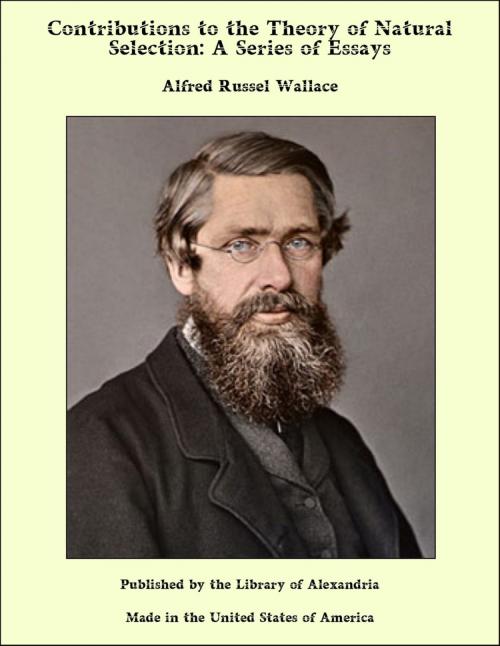Contributions to the Theory of Natural Selection: A Series of Essays
Nonfiction, Religion & Spirituality, New Age, History, Fiction & Literature| Author: | Alfred Russel Wallace | ISBN: | 9781465610775 |
| Publisher: | Library of Alexandria | Publication: | March 8, 2015 |
| Imprint: | Language: | English |
| Author: | Alfred Russel Wallace |
| ISBN: | 9781465610775 |
| Publisher: | Library of Alexandria |
| Publication: | March 8, 2015 |
| Imprint: | |
| Language: | English |
Every naturalist who has directed his attention to the subject of the geographical distribution of animals and plants, must have been interested in the singular facts which it presents. Many of these facts are quite different from what would have been anticipated, and have hitherto been considered as highly curious, but quite inexplicable. None of the explanations attempted from the time of Linnæus are now considered at all satisfactory; none of them have given a cause sufficient to account for the facts known at the time, or comprehensive enough to include all the new facts which have since been, and are daily being added. Of late years, however, a great light has been thrown upon the subject by geological investigations, which have shown that the present state of the earth and of the organisms nowinhabiting it, is but the last stage of a long and uninterrupted series of changes which it has undergone, and consequently, that to endeavour to explain and account for its present condition without any reference to those changes (as has frequently been done) must lead to very imperfect and erroneous conclusions. The facts proved by geology are briefly these:—That during an immense, but unknown period, the surface of the earth has undergone successive changes; land has sunk beneath the ocean, while fresh land has risen up from it; mountain chains have been elevated; islands have been formed into continents, and continents submerged till they have become islands; and these changes have taken place, not once merely, but perhaps hundreds, perhaps thousands of times:—That all these operations have been more or less continuous, but unequal in their progress, and during the whole series the organic life of the earth has undergone a corresponding alteration. This alteration also has been gradual, but complete; after a certain interval not a single species existing which had lived at the commencement of the period. This complete renewal of the forms of life also appears to have occurred several times:—That from the last of the geological epochs to the present or historical epoch, the change of organic life has been gradual: the first appearance of animals now existing can in many cases be traced, their numbers gradually increasing in the more recent formations, while other species continually die out and disappear, so that the present condition of the organic world is clearly derived by a natural process of gradual extinction and creation of species from that of the latest geological periods. We may therefore safely infer a like gradation and natural sequence from one geological epoch to another. Now, taking this as a fair statement of the results of geological inquiry, we see that the present geographical distribution of life upon the earth must be the result of all the previous changes, both of the surface of the earth itself and of its inhabitants. Many causes, no doubt, have operated of which we must ever remain in ignorance, and we may, therefore, expect to find many details very difficult of explanation, and in attempting to give one, must allow ourselves to call into our service geological changes which it is highly probable may have occurred, though we have no direct evidence of their individual operation.
Every naturalist who has directed his attention to the subject of the geographical distribution of animals and plants, must have been interested in the singular facts which it presents. Many of these facts are quite different from what would have been anticipated, and have hitherto been considered as highly curious, but quite inexplicable. None of the explanations attempted from the time of Linnæus are now considered at all satisfactory; none of them have given a cause sufficient to account for the facts known at the time, or comprehensive enough to include all the new facts which have since been, and are daily being added. Of late years, however, a great light has been thrown upon the subject by geological investigations, which have shown that the present state of the earth and of the organisms nowinhabiting it, is but the last stage of a long and uninterrupted series of changes which it has undergone, and consequently, that to endeavour to explain and account for its present condition without any reference to those changes (as has frequently been done) must lead to very imperfect and erroneous conclusions. The facts proved by geology are briefly these:—That during an immense, but unknown period, the surface of the earth has undergone successive changes; land has sunk beneath the ocean, while fresh land has risen up from it; mountain chains have been elevated; islands have been formed into continents, and continents submerged till they have become islands; and these changes have taken place, not once merely, but perhaps hundreds, perhaps thousands of times:—That all these operations have been more or less continuous, but unequal in their progress, and during the whole series the organic life of the earth has undergone a corresponding alteration. This alteration also has been gradual, but complete; after a certain interval not a single species existing which had lived at the commencement of the period. This complete renewal of the forms of life also appears to have occurred several times:—That from the last of the geological epochs to the present or historical epoch, the change of organic life has been gradual: the first appearance of animals now existing can in many cases be traced, their numbers gradually increasing in the more recent formations, while other species continually die out and disappear, so that the present condition of the organic world is clearly derived by a natural process of gradual extinction and creation of species from that of the latest geological periods. We may therefore safely infer a like gradation and natural sequence from one geological epoch to another. Now, taking this as a fair statement of the results of geological inquiry, we see that the present geographical distribution of life upon the earth must be the result of all the previous changes, both of the surface of the earth itself and of its inhabitants. Many causes, no doubt, have operated of which we must ever remain in ignorance, and we may, therefore, expect to find many details very difficult of explanation, and in attempting to give one, must allow ourselves to call into our service geological changes which it is highly probable may have occurred, though we have no direct evidence of their individual operation.















